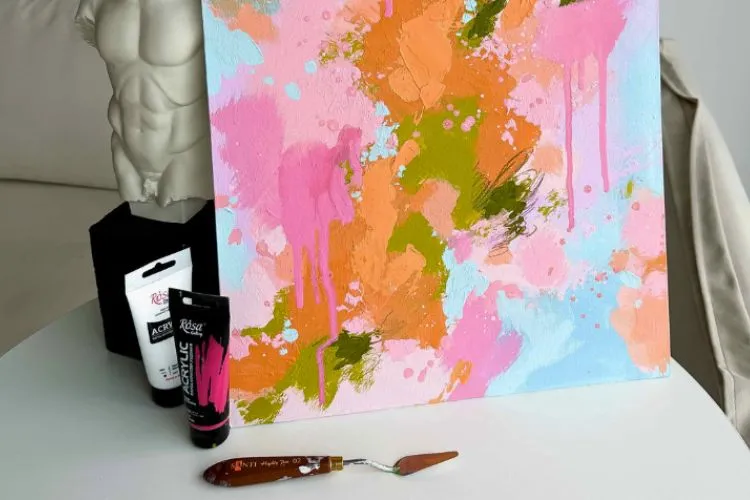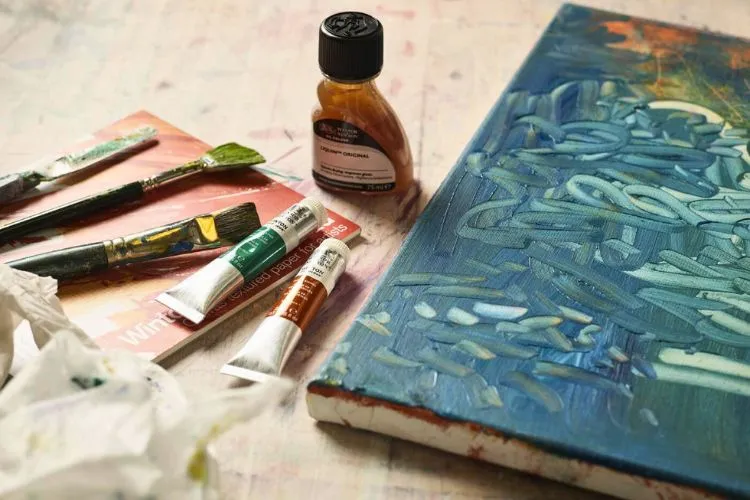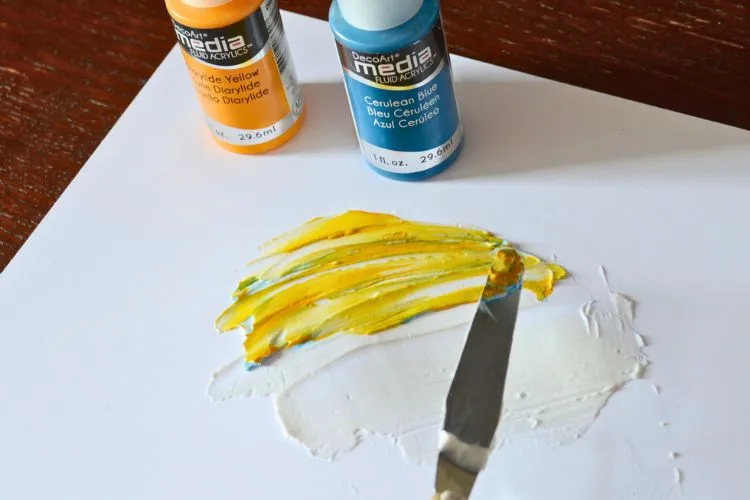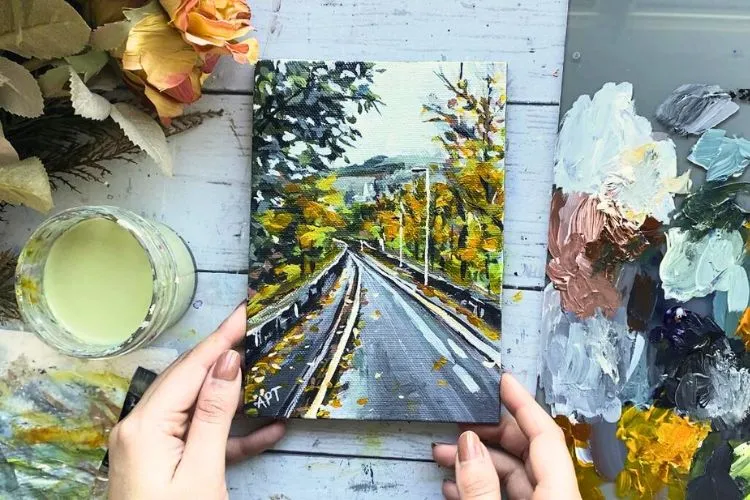Acrylic paint is a favored medium among artists due to its versatility and vibrant color. Layering is a fundamental technique that allows painters to create depth, form, and nuance in their work.
By developing a mastery of layering, artists can impart a sense of realism or drama to their paintings. This article aims to provide a detailed guide on how to layer acrylic paint.

Understanding Acrylic Paint
Acrylic paint is known for its quick drying time and water solubility. Its unique properties make it ideal for building up layers in a painting. Acrylics can be thinned with water or mediums and built up to create textures or smooth gradients of color.
Materials Needed for Layering Acrylic Paint
A good layering technique begins with the right materials. You’ll need a variety of brushes, a canvas prepped with gesso, a palette for mixing, and quality acrylic paints.
Selecting the appropriate type of acrylic paint, such as heavy body or fluid acrylics, can affect how layers interact with one another.
Basic Techniques for Layering
Before we begin layering, prepare the canvas with a layer of gesso. This primes the surface and ensures that subsequent layers adhere properly. Underpainting is the next step.

It sets the tone of the painting and acts as a guide for subsequent layers. Glazing with translucent layers of paint can add richness and depth. You’ll want to use mediums that are designed for glazing to achieve the best effect.
How To Layer Acrylic Paint?
First Layer: Blocking in Colors
The first step in layering is to block in your colors. This creates a map of your painting and is crucial for establishing the composition. The paint should be thinned enough to spread easily but still opaque enough to cover the canvas.
Second Layer: Building Mid-tones
After the base layer is dry, begin building the mid-tones. This layer starts to give the painting dimension. Use thicker paint and bolder strokes to start defining shapes and forms.
Subsequent Layers: Adding Details and Texture
As more layers are added, focus on details and textures. Techniques, such as dry brushing, add highlights and detailing. A palette knife can be used to apply thick paint directly onto the canvas to create texture.
Tips for Successful Layering
One critical tip for layering is to let each layer dry completely before proceeding. This prevents unwanted blending and maintains the vibrancy of your colors.

Additionally, vary the thickness of each layer to enhance the visual interest of your painting.
Advanced Layering Techniques
Understanding when to use wet-on-wet versus wet-on-dry techniques is crucial. Wet-on-wet is great for blending colors directly on the canvas, whereas wet-on-dry provides sharper contrasts and details. Impasto, or very thick paint application, is used to create dramatic textures and depth.
Troubleshooting Common Layering Issues
Issues such as difficulty blending, paint lifting off the canvas, or colors becoming muddy are common when layering. Each has its solution, from adjusting the paint’s consistency to adding a medium to improve adhesion.
Pre-Layering Preparation
Before embarking on layering acrylic paint, a series of preparation steps can significantly influence your final outcome. Understanding the impact of Surface Texture Considerations is crucial.
A smooth surface is ideal for fine details, while a more textured one can add depth and interest to your painting. Mixing Colors for Layering involves not just selecting hues that harmonize but also ones that create the desired effects when layered over each other.
This brings us to Testing Your Color Palette on a similar surface to your final canvas. It’s a vital step to foresee how colors interact, their opacity, and the effect of light.
Such preparatory steps ensure a solid foundation, preventing future corrections and enhancing the painting’s quality from the ground up.
You may also find useful: How to Make Acrylic Paint More Opaque? | How to Fix Cracked Acrylic Painting?
Layering Techniques for Different Effects
Employ various techniques to enrich your painting’s texture and visual impact. Sgraffito, using a pointed tool to scratch into the wet paint layer, creates dramatic textures.

Washing involves thinning acrylic paint to mimic the fluidity and transparency of watercolors, ideal for soft backgrounds.
Stippling, tapping a stiff brush onto the canvas, generates a unique, dotted texture, perfect for enhancing details and adding depth.
Caring for Layered Acrylic Paintings
To keep your layered painting looking its best, apply a varnish for protection. Make sure to handle the painting with care and store it properly to prevent damage.
Pro Tips
Keep your workspace clean to prevent accidental smudging or mixing of colors. Remember the ‘fat over lean’ rule, which means applying thicker layers of paint over thinner ones to prevent cracking. Also, working with a limited color palette can ensure a cohesive look in the final painting.
Frequently Asked Questions (FAQs)
How long do you wait between layers of acrylic paint?
It depends on the thickness of the paint, but generally, it’s about 20 to 30 minutes for thin layers and up to an hour for thicker ones.
Can you layer acrylic paint over oil paint?
No, acrylic paint does not adhere well to oil paint, and the flexibility of acrylics differs from oils, which can cause cracking.
How many layers can you apply with acrylic paint?
You can apply as many layers as you want, provided each layer is dry and the ‘fat over lean’ rule is observed.
What are the best brushes for layering acrylic paint?
Synthetic brushes work well for smooth layers, while natural bristle brushes are good for textured layers.
Are there any mediums that can speed up or slow down the drying time between layers?
Yes, there are mediums available to alter the drying time of acrylic paints. A retarder can slow down drying, while an acrylic flow improver can speed it up.
Conclusion:
Layering acrylic paint is a skill that adds depth and life to your work. With practice and patience, artists can use these techniques to create complex and textured paintings.
By carefully following this structure, the writer should create an engaging and informative piece that remains within the Hemingway App readability guidelines.
The article should focus squarely on the process of layering acrylic paint, foregoing any unnecessary complexity in favor of clear, concise guidance.

Meet Isabella Anderson, your acrylic painting mentor with over a decade of brush-wielding mastery. Dive into the colorful world of acrylics with her expert guidance, featured exclusively on ‘Acrylic Authority.’ Unleash your inner artist and explore the limitless possibilities of this versatile medium alongside a true acrylic aficionado.
